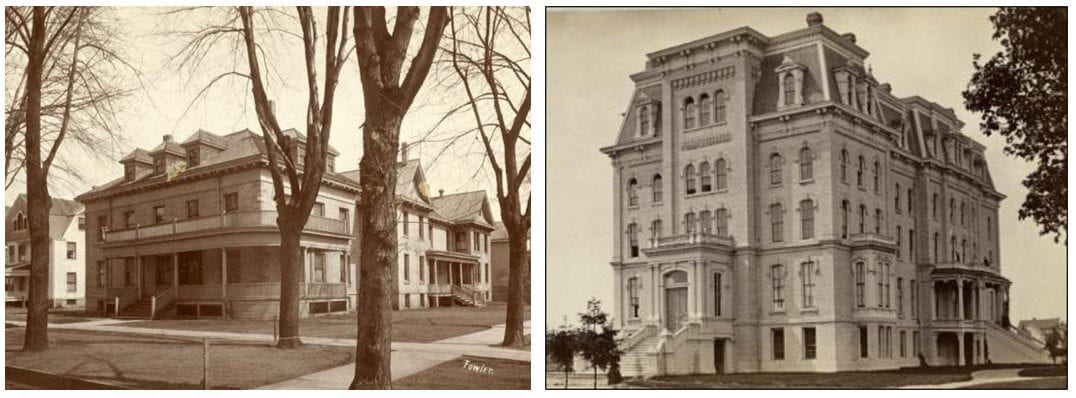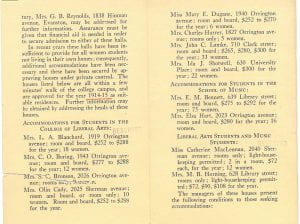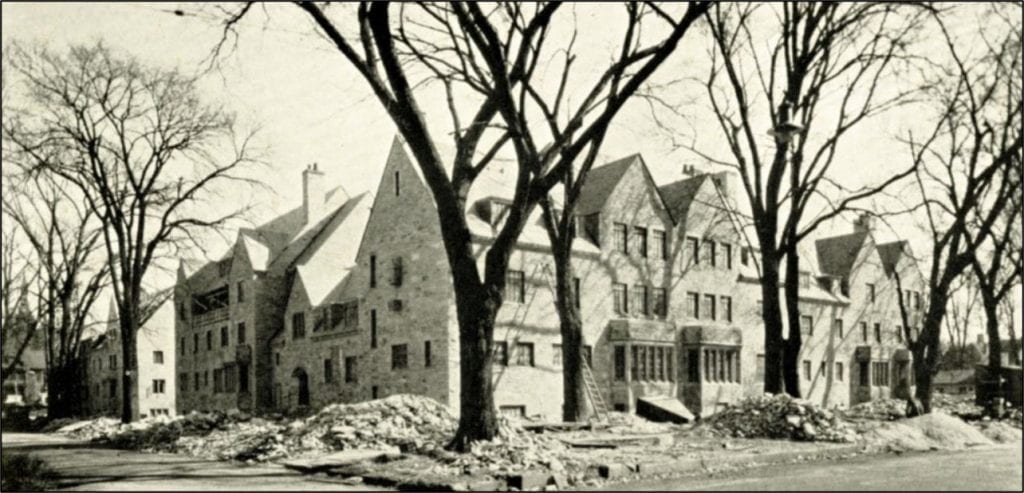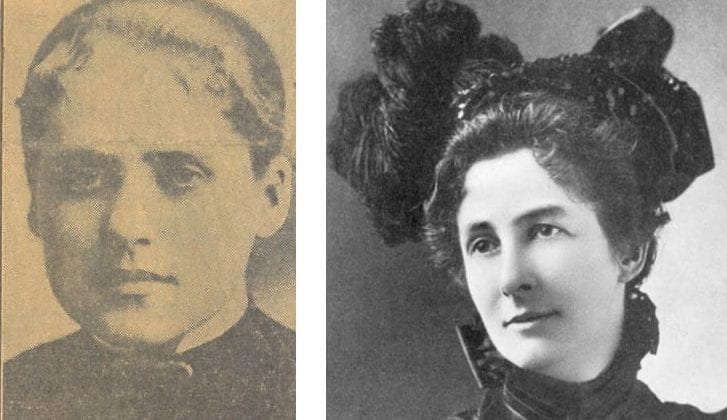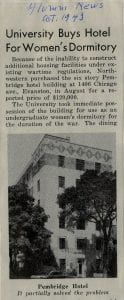“On the Same Terms” is an exhibition and blog series dedicated to this academic year’s commemoration of the 150-year anniversary of the admission of women to Northwestern.
Northwestern’s success as a coeducational school was based on assuring parents that their daughters would encounter a safe, homelike atmosphere — with parental-quality supervision. At first, local women students lived at home, and women from “abroad” (anywhere outside Evanston) boarded with carefully selected families in town or lived in the old North-Western Female College building a mile from campus.
College Cottage and Woman’s Hall
In 1872, Evanston women established the Women’s Educational Aid Association (WEAA) to house women while helping them afford the cost of room and board. The WEAA instituted a co-op plan, similar to a plan in place at Mount Holyoke, that offered a reduced rate in exchange for an hour or two of housework. A building at the corner of Orrington and Clark was purchased (by the husbands of WEAA members), and by October 1872, “College Cottage” was ready for occupancy.
Then, in 1874, Woman’s Hall (later called Willard Hall) opened, increasing the space available for women students, at a cost of $5 per week for room and board (room and board at College Cottage cost $2.25 per week). Both the Woman’s Hall and College Cottage were soon filled; both added annexes, and in 1901, the WEAA built an additional residence, Chapin Hall. The WEAA eventually administered three buildings; the co-op system remained in place until 1967.
Still, by 1915, over 1,300 women were enrolled at Northwestern, far exceeding the 240-person capacity of Willard and the co-op dormitories. Northwestern’s annual Student Handbook continued to include a list of approved boarding houses in Evanston, and women from Chicago and nearby suburbs commuted to campus from their family’s homes.
Men’s campus housing had long lagged behind women’s. Finally a building spree in 1914 resulted in 17 buildings —the Men’s Quadrangle—on the North Campus. Thirteen were fraternity houses, funded by the national entities, and four housed unaffiliated men.
But it took until 1924, after much pressure, for the University to duplicate these efforts for women. In 1926, construction began on a Women’s Quadrangle (also called the Women’s Campus), with 14 buildings funded by and for sororities and two unaffiliated houses. The houses were designed by James Gamble Rogers, the architect of the Chicago Campus and Deering Library. The unaffiliated houses were named for alumna Emily Hobart (1882, 1887), who died as a missionary in China, and Emma W. Rogers, wife of former University president Henry Rogers.
The Second Willard Hall, 1938
The women’s residences soon filled, and in 1938 a new 300-bed dormitory, intended as “a haven for freshmen women,” was built at the west end of the Women’s Quads. The building was named Willard Hall (to commemorate the 100th anniversary of Frances Willard’s birth in 1839) and the original Willard Hall eventually became the Music Administration Building (until 2015).
The War Years and Beyond, 1938-1952
No new dormitories were built during or immediately after the War, although the campus was filled to overflowing with women and men students. To deal with the influx of women, Northwestern bought Pembridge House (1406 Chicago Avenue), a former apartment hotel; arranged for a floor of rooms in the North Shore Hotel (Davis and Chicago); and housed some women in Sargent Hall and the Northwestern Apartments.
More Housing for Women, 1952-60
After Centennial fundraising efforts in 1951, Northwestern was able to construct two new women’s dorms: Shepard Hall, in 1952, and Allison Hall, in 1960. After an addition in 1960, Shepard could house 175 women; Allison 362—the largest residence hall at the time. Both were funded by gifts from women donors.
Changing Times, 1967-1993
In 1967, the WEAA turned Chapin Hall over to Northwestern as a regular woman’s dorm, ending the century-long co-op system. By 1973, the Women’s Self-Government Association had disbanded, there was no longer a dean of women, restrictions on visiting hours for men and women were lifted, and co-ed dorms and residential colleges changed the face of residential life at Northwestern forever. The west side of Allison Hall became a residential college focusing on Women’s Studies in 1976. By 1980, the residents were not happy with their space, and in 1982, the WSRC was moved to Hobart House, where, in 1993, it took on the name Women’s Residential College. And aside from sororities and fraternities, Hobart House remains the only single-sex residence on campus.
The Struggle for Interracial Housing
For some women students, living in campus housing wasn’t possible even if there were rooms available. In fall 1902, Isabella Ellis, a Black student from San Antonio, Texas, planning to return for her second year, was not able to obtain a room at Chapin Hall as she had the previous year. During her first year, Ellis had been given a double room to herself, since no white women students would share a room with her. According to a newspaper report, “It was not known that she was colored until she arrived.” The report added that, at the end of the year, a number of the Chapin residents stated that they would not return to the hall “if colored coeds were admitted again.” The Women’s Educational Aid Association, which administered Chapin, voted after much discussion to tell Ellis that she could not have a double room to herself again and so could not live at Chapin. Ellis did not return to Northwestern.
This story of discrimination was reported in numerous newspapers. Faculty and administration pointed out that Chapin Hall was not under University jurisdiction, and denied that there was a “color line” in Northwestern housing. Still, African American students were housed off-campus, boarding with families in Evanston (men students could live at the Emerson YMCA), until the 1960s, under Northwestern’s “selective housing” policy.
International House, 1947: In response to student demands, the University experimented with its first interracial dorm, opening International House (1827 Orrington—off campus) in 1947. The house held 16 women students. In the first year, residents were described as “eight Negroes, three white, and one Japanese” (despite all of them being American citizens). The house only lasted a year, and was discontinued because it could not attract enough residents.
All images and documents are drawn from the University Archives Collections. Images from the Daily Northwestern and the Syllabus yearbook are used courtesy of Students Publishing Company.
Fall 2019 marked 150 years since women could enroll as Northwestern undergraduate students. Visit the 150 Years of Women website to learn more and get involved.

